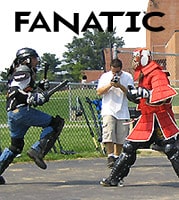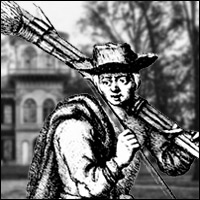Alex from Athens posted the following comment on The Fighter’s Eye
“When you talk about specific muscular conditioning for stick fighting, what does it entail? It is obvious, that you need a durable grip. But what other muscles are involved and how can you strengthen them, besides beating something with a stick? As I am thinking on it now, maybe the best way is to beat regularly something with a stick, because once I was swinging a rattan stick in the air for some time and then I could'nt close my hand for a week.”
Alex. I am linking this article to Doc Lumsden’s email. Doc is a stick-fighter and MMA coach as well as a hand surgeon, so we will leave the diagnosis as to what would have prevented your hand closing to him. Keep an eye on this article for comment postings to see what he has to say.
I will provide a training regimen below. Some of these exercise are difficult for me to mechanically describe. So, as per your previous request, we will shoot a video of my fat ass doing each exercise and then add it to this article. Keep an eye-out for the film icon to appear on this article in a week or two [any corrections or additions to an article cause it to advance to the top of the main page].
The Grip
Do not squeeze the stick too vigorously. It is important—as in boxing—to practice missing more than hitting, as, against any dangerous opponent, that will be the reality. We must practice with and without resistance. We start without resistance.
Let us forget forever the notion of ‘swinging’ a stick. Never, ever ‘swing’ a stick. We chop into, slash through, rap, stab, rake and dump into the target. We don’t swing brother—ever.
Hold the stick one fist from the butt.
The thumb and first finger are for control and should lightly encircle the stick and may be tightened on impact or for recovery of a missed stroke.
The middle finger and ring finger should grip with strength, perhaps 70-80% of grip strength, to be tightened to 100% on impact and if your stick is grabbed.
The pinkie finger is the closer. He is resting on the stick, not fully wrapped unless you have big hands and are using a thin stick. On impact this finger is flexed to the max, fully engaging the flexor muscle and tendon that attach to the inside of the elbow and make us old stick fighters look like Popeye the Sailor man eating his spinach when we tilt our beer. The belly of this forearm muscle is used to bury that stick in, or rip it through, the target.
We will get into more forearm mechanics on the bag drills. For now you want to smoothly develop the ability to stroke with your stick as if it were a blade [in case it is one day] to avoid bruising the inside of your thumb or losing your stick on impact. The portion of the stick you hit and defend with must be that which aligns with the face of your fist. You are not hitting with the side of the stick. You want the force of impact to be absorbed by the palm of your hand in line with your two supporting wrist bones.
With a blade you would slash or cleave edge on, never letting a bounce occur.
With a stick you slash or bury it in the target, and sometimes let it bounce back to guard, for instance when rapping hands from outer range or when fanning the head in the clinch.
The Sticks
I use sets of sticks ranging in thickness from a half inch to an inch and a half, always warming up with thinner sticks and moving to heavier. I recommend you train with the following variety of sticks. The varying thicknesses I mentioned above need only apply to the long sticks. The long sticks are what will beat up your wrist. We train, spar and compete with three stick lengths, and I recommend you train with all three.
1. Long Sticks are 26-31 inches, with 28 being the preferred length and ¾ inches the normal thickness
2. Short sticks are 16-20 inches and are used as 1 inch batons and also as ½ inch ‘blunts’ to represent machetes and long knives such as Arkansas toothpicks in sparring.
3. ‘Knife’ sticks are 12-14 inches and are generally used to represent Bowie knives, dagas and butcher knives in sparring, as well as training to use rolled up magazines, flashlights and hand umbrellas for defense, survival and vengeance.
Most FMA people start out holding a long stick in the middle and doing a plyometric bounce, fanning it back and forth. If you have a job that causes strain to the forearm muscles such as writing, moving furniture, or working as a fluffer on a lesbian porno set, than getting right into your stick training with this exercise is stupid. You could tear something. Although I have developed my forearms quite a bit I have also suffered a number of injuries including tears to the flexor tendons which were treated by Doc Lumsden. Below is my solo routine, which will be supplemented later with video. All exercises are with the long stick unless stated otherwise. Sets are about thirty seconds with each hand, or 3 counts with each hand. What follows is not bag work [unless stated] but shadow work.
1. Slow forward figure eight
2. Slow reverse figure eight
3. Slow fan, middle grip
4. Slow fan, fight grip
5. Side twirl
6. Slash and twirl recovery
7. Roof block drill with two sticks
8. Drummer raps with knife stick
9. Drummer raps with short stick
10. Circle raps
11. Circle raps with foot work
12. Slow count* without footwork
13. Slow count with foot work
14. Slow count with footwork and heavy stick
15. Slow count with footwork and knife stick
16. Defense without foot work and heavy stick
17. Defense with footwork and heavy stick
18. Snakey stick with footwork
19. Slash count with light stick
20. Slash count with heavy stick
21. Slash count with footwork with light stick
22. Slash count with footwork with heavy stick
23. Kneeling, grab two knife sticks and do a drumbeat on a roll of carpet, a prone punching bag, your disobedient slave girl’s rump, etc.
24. Stick bounce
25. Stick stretch
26. Stick twist
Basic ‘Crooked 7’ Stick Count
1. Diagonal forehand
2. Lateral backhand
3. Lateral forehand
4. Diagonal backhand
5. Vertical fist gut stab with checking hand
6. Rising diagonal forehand with evasive step
7. Vertical backhand with step
Footwork with the crooked seven should be 1 step per stroke. You are learning to put your whole body into the stroke rather than it being an arm technique. Moving slowly as you stroke [and starting your exercises and stroke counts slowly] will help you concentrate on form. Make sure to turn your hand as soon as through the target or—if missing and cutting air—as soon as the wrist begins to break as defined by the baseball batting rule.
Goals
The competition stick-fighter must be able to stun or injure a gloved hand, a masked head, or a fit body with a stroke that uses only forearm mechanics. Likewise the defender, survivalist or avenger must be able to KO a man with a rolled magazine or hand umbrella [striking with the handle] with one stroke to the temple ear or jaw without swinging, but with a chopping motion.
Alex, good luck with your training and take it slow and easy. Learning slowly will facilitate fast function in the long run.
In the future Charles, Erique and I shall post videos of bag work, impact shield training, and tap sparring for stick-fighting and self-defense.











So many thanks Mr LaFond!Such an informative response!I consider your answers" scientific",and in my view this is the way to teach martial arts,concetrating on mechanics and body structure.I will try the exercises and i am sure that they will help,not only the conditioning of the muscles,but muscle memory for stick work, as well.Deep appreciation and many thanks in advance to you and Mr Charles and Mr Erique.By the way nice suggestion for the surface in exercise number 23!
This is for information purposes only! I don't need your slave girl hunting me down!
James provides a great and informative piece here on the question at "hand." To clarify, I am a general orthopedic surgeon and I do treat general hand issues as well. Having fought full contact stick, mma etc and other martial arts, including filipino, I am always impressed with Mr. Lafond's knowledge. My own hands have sustained 14 fractures in my lifetime, some from fighting. None of it came from poorly conditioned hands. As one of my instructors once said, "the best way to condition your body (hands) is to insure your technique is best." James alludes to this with hand grip etc. With that said, having strong joints and muscles of the hands can only help in any physical endeavor. I agree don't swing a stick. Warm up, work all motions and angles. Utilize resistive exerercises (grips, finger exercises, forearm strengthening, finger push ups, but also strengthen the wrist). Utilize longer, heavier sticks, and change the mechanics of the weight to the proximal end versus the distal end of the stick as well. There are intrinsic muscles of the hand, but there are also tendons attached to muscles that originate from the forearm so you must address the entire complex: forearm, wrist and hand. Personally, I use various "weighted" sticks and hit a variety of different densities of targets. There are a number of intrinsic muscle exercises for the hands but a bit difficult to describe here on such a forum.
Thanks David.